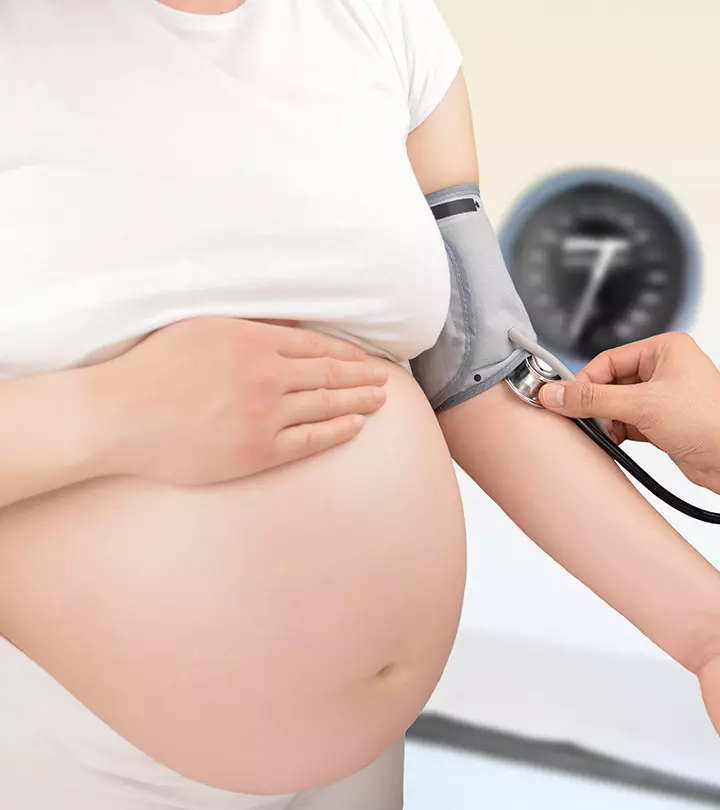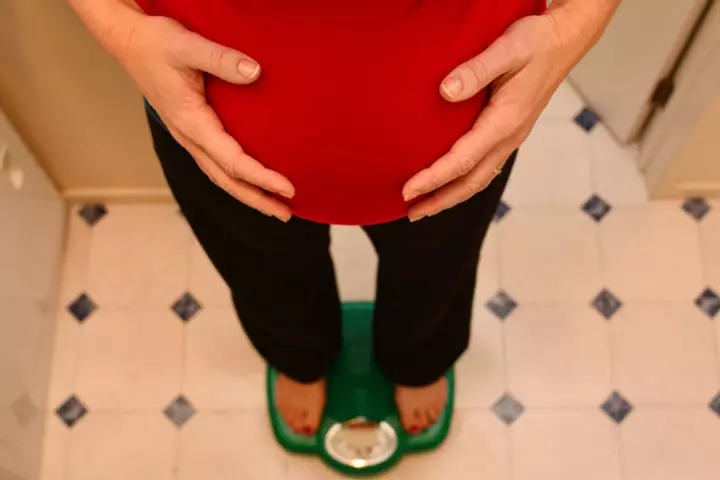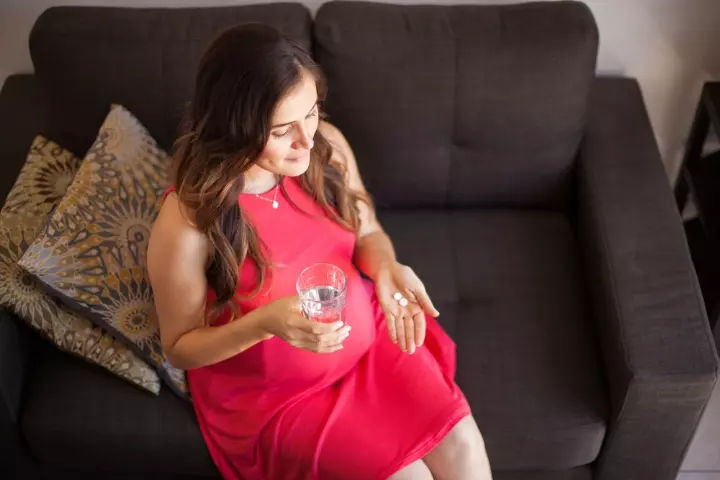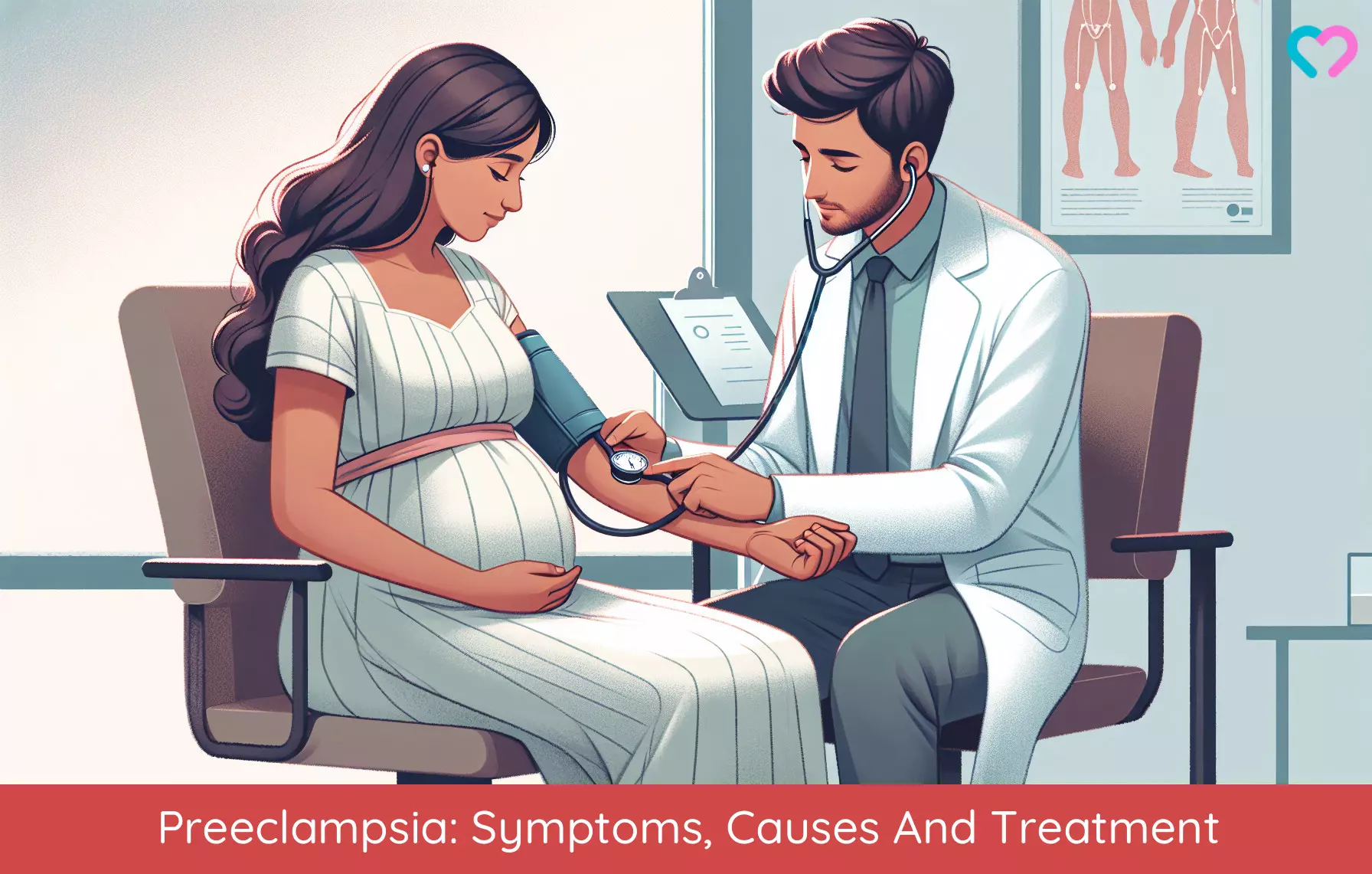
Image: iStock
Preeclampsia in pregnancy is a condition characterized by high blood pressure and high protein in the urine during pregnancy or right after delivery. It usually develops after 20 weeks of pregnancy. Occasionally, preeclampsia may even develop in the first six weeks of postpartum. Early-onset preeclampsia may occur before 34 weeks of pregnancy and is often accompanied by severe symptoms.

Preeclampsia can occur in pregnant women with existing chronic hypertension or previously normal blood pressure. The US Centers for Disease Control and Prevention (CDC) reports that the condition affects one in 25 women (1). The disorder affects the woman’s organs and risks the unborn baby’s health.
Learn more about the symptoms of preeclampsia in pregnancy, its causes, risk factors, prevention, diagnosis, and treatment.
Key Pointers
- Preeclampsia in pregnancy is indicated by high blood pressure and high protein levels in the urine.
- The condition may cause headaches, nausea, edema, and heartburn.
- History of chronic hypertension, obesity, and diabetes are a few risk factors for preeclampsia.
- Some complications associated with the condition are premature birth, placental abruption, and multiorgan damage.
Signs And Symptoms Of Preeclampsia
The early symptoms and signs of preeclampsia may include (2):
- Hypertension (high blood pressure where systolic blood pressure>= 140 mm of Hg, and diastolic blood pressure>= 90 mm of Hg)
- Proteinuria (proteins in the urine)
High blood pressure alone cannot suggest preeclampsia, and this may indicate other problems. A combination of these symptoms suggests the presence of preeclampsia. Pregnant mothers do not often notice these symptoms and are often identified during medical checkups in routine antenatal care (prenatal) visits.
Pregnant mothers may experience the following symptoms as the preeclampsia progresses (2).
- Severe headaches

- Nausea and vomiting
- Vision issues such as seeing flashing lights or blurred vision
- Pain in upper abdomen
- Weight gain due to fluid retention
- Sudden edema (swelling) on face, hands, legs, and feet
- Decreased urination
It is recommended to contact your doctor right away if you notice any of these symptoms rather than waiting for the next prenatal visit.
Detecting and monitoring preeclampsia early is important to help prevent complications. Regular antenatal checkups help identify early warning signs like high blood pressure and protein in the urine.
 Things to know
Things to knowRisk Factors And Causes Of Preeclampsia
The exact causes of preeclampsia are not identified in many cases. However, placental problems are often associated with the development of preeclampsia in many women. This can also be due to poor development of placental blood vessels in women with preeclampsia in early pregnancy (3).
The following conditions or factors may increase the risk of developing preeclampsia (3) (4).
- Maternal age less than 20 or more than 40
- History of chronic hypertension
- History of preeclampsia in previous pregnancies
- Expecting the first baby
- Overweight or obese

- Positive family history of preeclampsia and chronic hypertension
- Kidney diseases
- Diabetes
- Multiple gestations
- Immune system disorders such as rheumatoid arthritisiA chronic autoimmune inflammatory condition characterized by swelling, stiffness, and pain in the joints. and lupusiAn autoimmune condition affecting multiple organs, including the muscular and nervous systems.
- In vitro fertilization
- Short or long intervals between pregnancies, such as having babies with less than a two-year gap or more than a ten-year gap
- New paternity may increase the risk of preeclampsia than next pregnancies with the same partner
Complications Of Preeclampsia
Pregnant mothers with uncontrolled preeclampsia are at higher risk of complications. Some of the complications are medical emergencies since, if left untreated, it can be life-threatening for both the mother and the unborn baby. Indeed, the Centers for Disease Control and Prevention revealed approximately 0.9 fatalities per 100,000 live births as a consequence of eclampsia and preeclampsia. You may seek emergency medical care if you notice any complications of preeclampsia at any time during the pregnancy.
Possible complications of preeclampsia may include (4):
- Intrauterine growth restriction (IUGR): Preeclampsia may reduce the blood flow in placental blood vessels. This may lead to inadequate delivery of oxygen and nutrients to the fetus, causing slow growth and low birth weight.
- Premature birth: Severe preeclampsia can be harmful to both mother and baby and often require early delivery by C-section or preterm labor induction. Doctors may give certain medications to enhance the baby’s lung maturity and plan the delivery based on the maternal health status and the baby’s condition. Cara Jane, a mother, shares her experience with preeclampsia and having a premature birth. She says, “I had an emergency C-section at 33 weeks. I went for a regular appointment where the nurse checked my blood pressure twice, and it came higher than usual. The nurse suggested I should go to the hospital and talked about inducing labor (i). Jane had her baby delivered by a C-section.”
- HELLP syndrome: This syndrome includes hemolysis (destruction of erythrocytes or red blood cells), low platelet count, and increased liver enzyme levels in the body. Headaches, nausea, vomiting, and upper right abdomen pain are symptoms of HELLP, and it indicates multiorgan damage. HELLP syndrome is the most severe form of preeclampsia, leading to life-threatening risks to the mother and the baby. This can have sudden onset even before the onset of symptoms or before detecting high blood pressure.
- Placental abruption: This is a condition where the placenta separates from the uterine wall before delivery. Severe placental abruption can be life-threatening to the mother due to heavy bleeding and the baby due to inadequate or lack of blood supply.
- Eclampsia: Preeclampsia with seizures (convulsions) is called eclampsia, and it is a medical emergency. This is usually when the preeclampsia is uncontrolled. There are no warning signs or symptoms to predict the risk of eclampsia, and this may pose serious health risks to maternal and fetal health.
- Multiorgan damage: Preeclampsia can cause maternal morbidity by damaging vital organs such as the kidneys, lungs, liver, heart, and eyes in the mother. This can also increase the risk of strokes that may result in brain injury. The severity of organ damage may depend on the severity of preeclampsia.
- Cardiovascular diseases: Preeclampsia may increase the risk of cardiovascular diseases in the future. The risk can be higher for mothers who had preeclampsia in more than one pregnancy and had a preterm delivery. However, maintaining weight, following a healthy diet, avoiding smoking, and regular exercise throughout life can minimize the risk.

The severity and risks of preeclampsia can be higher if it occurs in early pregnancy. In some cases, an early delivery through cesarean section (C-section) is recommended to avoid severe obstetric complications.
Prevention Of Preeclampsia
There are no clear strategies to prevent preeclampsia. However, trying to be healthy, such as keeping weight in the normal range, and managing chronic conditions, such as hypertension or diabetes, can be helpful to reduce the risk of preeclampsia, especially if you had it before. Seeking regular prenatal care can help to limit complications if you are already pregnant.
The following medications may reduce the risk of preeclampsia in some women (4):
- Low-dose aspirin: Daily low-dose aspirin can be prescribed for pregnant women with certain risk factors for preeclampsia from 12 weeks of pregnancy. Usually, aspirin is prescribed for women with risk factors such as kidney diseases, chronic hypertension, autoimmune diseasesi, diabetes, multiple pregnancies, and a history of preeclampsia.

- Calcium supplements: Women with calcium deficiency before or during pregnancy may benefit from calcium supplements to prevent preeclampsia. Calcium deficiency is less common in the US and many other developed countries.
Restricting calories, reducing salt consumption, and consuming fish oil or garlic are not scientifically proven to prevent preeclampsia. Vitamin C and E intake are also not shown to have many benefits in preeclampsia prevention. Although some studies show that vitamin D is beneficial to lower preeclampsia risks, others fail to establish the link. So you may inform your doctor before taking any medications or supplements.
 Quick fact
Quick factDiagnosis Of Preeclampsia

Blood pressure measurements and urine tests can help determine preeclampsia. If these test results indicate the presence of preeclampsia, doctors may order liver and kidney function tests and platelet measurements through blood tests.
In later stages, fetal ultrasound and biophysical profileiTests performed to evaluate the health status of the fetus, including fetal muscle tone, heart rate, and amounts of amniotic fluid. help determine the unborn baby’s health. Prenatal ultrasounds may also help to identify placental abnormalities and growth restrictions due to preeclampsia (5).
Treatment For Preeclampsia
The most effective treatment for preeclampsia is delivery. Hospitalization is needed for preeclampsia with severe features. Delivery is recommended as early as possible. However, you may wait for delivery if the condition is stable. Delaying delivery allows time to give corticosteroids to enhance fetal lung maturity.
In addition, mothers may receive antihypertensive medications to decrease blood pressure and anticonvulsants to prevent seizures. However, if the condition is not stable, immediate delivery is recommended (5). If the benefits outweigh the risks, doctors may recommend an early delivery by labor induction with medications or cesarean section to prevent life-threatening complications in both mother and baby. This decision may be crucial to reduce maternal mortality and fetal mortality.
Frequently Asked Questions
1. Can a baby survive preeclampsia?
If diagnosed and treated, most women with preeclampsia have healthy babies. However, untreated preeclampsia could cause complications for the mother and the baby (6).
2. Which is the week when preeclampsia is most common?
Preeclampsia is often diagnosed around the 20th week of pregnancy. However, it is most common around the 37th week of gestationiThe period of carrying and developing an embryo or fetus until birth within the female womb. (3).
3. How do I test for preeclampsia at home?
The diagnosis of preeclampsia must be done by a medical professional. However, you may check your blood pressure at home using reliable equipment. It might be helpful to get the accuracy of the equipment checked by your doctor once. Note down the readings each time and keep your doctor updated about them. If you notice high blood pressure at home, inform your doctor. Also, ensure to visit your doctor frequently throughout the pregnancy for regular prenatal health checkups.
Preeclampsia in pregnancy occurs after 20 weeks, and it is associated with high blood pressure and a high content of protein in urine during pregnancy. It can result in maternal multi organ damage, growth restriction, and premature birth in babies. This may occur in women with normal blood pressure or high blood pressure. It is essential to manage pregnancy-induced hypertension and go for follow-ups since it may increase the risk of cardiovascular diseases in the future. Calcium supplements and low-dose aspirin are usually given to help prevent preeclampsia in high-risk groups.
Infographic: Risk Factors Associated With Preeclampsia In Pregnancy
Preeclampsia is a significant pregnancy-related complication that can affect the mother and the baby. However, understanding the risk factors can help in early diagnosis and management of the condition. Explore the following infographic to learn about factors that increase the likelihood of developing preeclampsia.
Some thing wrong with infographic shortcode. please verify shortcode syntaxIllustration: Preeclampsia: Symptoms Causes And Treatment

Image: Dall·E/MomJunction Design Team
Preeclampsia is a serious life-threatening condition that can affect pregnant women. Learn how to recognize the signs and manage them during pregnancy. Also, learn the importance of follow-up care in this informative video.
Personal Experience: Source
MomJunction articles include first-hand experiences to provide you with better insights through real-life narratives. Here are the sources of personal accounts referenced in this article.
i. My birth story! Emergency c-section at 33 weeks!! | preeclampsia;https://www.youtube.com/watch?v=IBt_1XmsNTo
References
- High Blood Pressure During Pregnancy.
https://www.cdc.gov/high-blood-pressure/about/high-blood-pressure-during-pregnancy.html - Preeclampsia.
https://www.nhs.uk/conditions/pre-eclampsia/symptoms/ - Preeclampsia.
https://my.clevelandclinic.org/health/diseases/17952-preeclampsia - Preeclampsia.
https://www.stclair.org/services/mayo-clinic-health-information/diseases-and-conditions/CON-20253615/ - Preeclampsia and High Blood Pressure During Pregnancy.
https://www.acog.org/womens-health/faqs/preeclampsia-and-high-blood-pressure-during-pregnancy - Preeclampsia.
https://www.marchofdimes.org/find-support/topics/pregnancy/preeclampsia - Sammya Bezerra Maia e Holanda Moura, et al.; (2012); Prevention of Preeclampsia
https://www.ncbi.nlm.nih.gov/pmc/articles/PMC3534321/
Community Experiences
Join the conversation and become a part of our nurturing community! Share your stories, experiences, and insights to connect with fellow parents.
Read full bio of Dr. Swati Chitnis
Read full bio of Dr Bisny T. Joseph
Read full bio of Rebecca Malachi
Read full bio of Reshmi Das

















